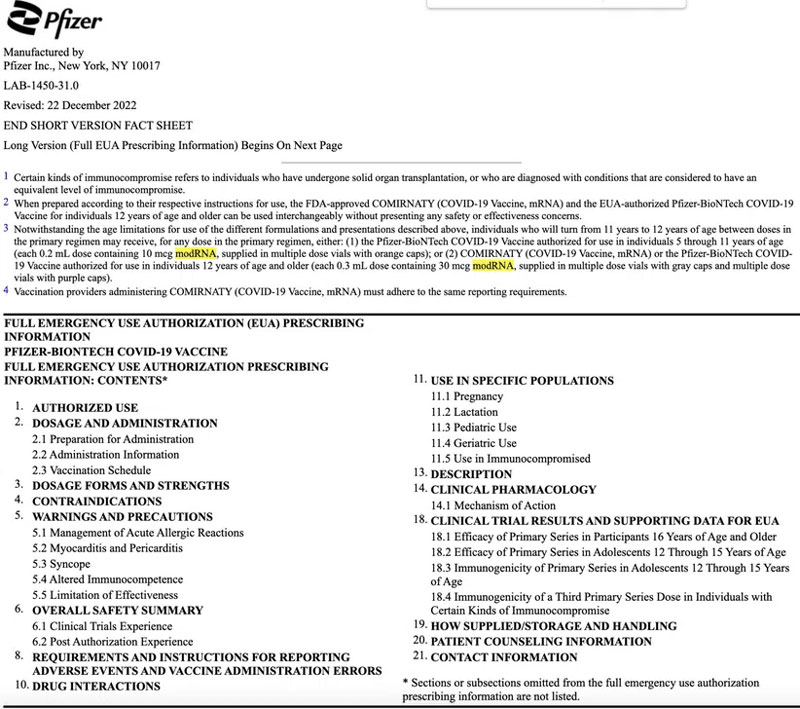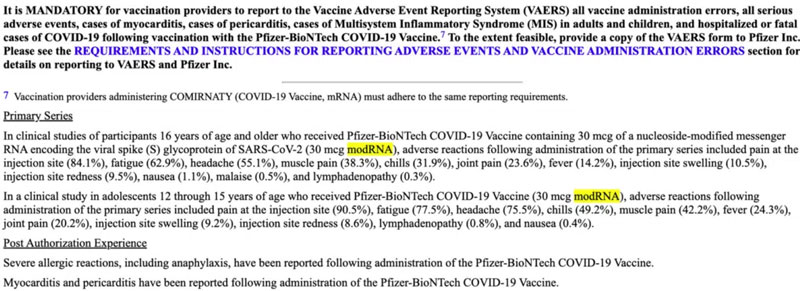Pfizer has revealed in an explosive admission that the pharmaceutical giant has been lying to cover up the fact that its so-called “mRNA” Covid shots actually “modify” human DNA.
According to newly released Pfizer papers, the “m” in mNRA does not stand for “messenger,” as we were told.
It actually stands for “mod” or “modified.”
Sharing his research on Twitter, lawyer Tom Renz exposed that the COVID-19 vaccines, widely advertised as mRNA (messenger RNA) vaccines, are in fact lab-created hybrids known as modRNA.
That’s right, mRNA is designed not to send a message within the DNA, but to MODIFY it.
Tom Renz has accused the Food and Drug Administration (FDA), Centers for Disease Control and Prevention (CDC), Pfizer, and others of misleading the world about the true nature of the COVID-19 vaccines – and waiting until after the vaccine roll-out to admit the truth about the experimental product.
In his statement, Renz claims that the widely recognized mRNA technology, allegedly utilized in the vaccines, is not what it appears to be.
“They claimed the COVID-19 vaccines were mRNA & that meant MESSENGER RNA (which occurs in life everywhere). It is NOT. The mRNA is modRNA. modRNA is a lab-created hybrid designed to create changes in your genes,” said Renz.
modRNA (modified messenger RNA) is a synthesized form of mRNA that has been altered at specific sites.
ModRNA, as described by Renz, has the potential to last longer and create permanent changes in genes. He also warns of the potential for “massive unintended consequences” in the 3300 billion lines of genetic code that make up humanity.
“Why does this matter? Well let’s start with the COVID “vaccines”. Because mRNA is a weak particle and breaks down easily with a relatively lower risk of messing with your genetics than other gene therapy products (like modRNA) that is what is always talked about in the jabs. The problem is that it is a lie,” Renz wrote on his Substack.
If you searched the word “modRNA” on Pfizer’s labeling/factsheet for health care providers administering the vaccine, it will show 21 results, GWP reports.
According to the labeling:
Notwithstanding the age limitations for use of the different formulations and presentations described above, individuals who will turn from 11 years to 12 years of age between doses in the primary regimen may receive, for any dose in the primary regimen, either: (1) the Pfizer-BioNTech COVID-19 Vaccine authorized for use in individuals 5 through 11 years of age (each 0.2 mL dose containing 10 mcg modRNA, supplied in multiple dose vials with orange caps); or (2) COMIRNATY (COVID-19 Vaccine, mRNA) or the Pfizer-BioNTech COVID-19 Vaccine authorized for use in individuals 12 years of age and older (each 0.3 mL dose containing 30 mcg modRNA, supplied in multiple dose vials with gray caps and multiple dose vials with purple caps).
Vaccination providers administering COMIRNATY (COVID-19 Vaccine, mRNA) must adhere to the same reporting requirements.

Pfizer admitted that during its clinical studies, participants aged 16 years and older received 30 mcg of nucleoside-modified messenger RNA (modRNA).
This is the main active ingredient in the Pfizer-BioNTech COVID-19 vaccine. Nucleoside-modified messenger RNA (modRNA) is a modified form of mRNA that encodes the spike (S) glycoprotein of the SARS-CoV-2 virus, the virus that causes COVID-19. The vaccine uses this technology to prompt the body’s immune system to recognize and fight the virus.
These are the side effects reported by individuals in the clinical trial after receiving the vaccine.
- Pain at the injection site (84.1%): The most common reaction, reported by over 84% of participants.
- Fatigue (62.9%): A feeling of tiredness or exhaustion was reported by nearly 63% of the participants.
- Headache (55.1%): Over half of the participants experienced headaches.
- Muscle pain (38.3%): Muscle soreness or discomfort was reported by over 38% of the participants.
- Chills (31.9%): Just under 32% of participants experienced chills.
- Joint pain (23.6%): This refers to pain in the joints, experienced by nearly 24% of participants.
- Fever (14.2%): Around 14% of the participants had a fever.
- Injection site swelling (10.5%): This refers to swelling at the location where the vaccine was injected, reported by 10.5% of participants.
- Injection site redness (9.5%): This refers to redness at the injection site, experienced by 9.5% of participants.
- Nausea (1.1%): Slightly more than 1% of participants felt nauseous.
- Malaise (0.5%): This refers to a general feeling of discomfort or unease, reported by 0.5% of participants.
- Lymphadenopathy (0.3%): This refers to the swelling of lymph nodes and was reported by 0.3% of participants.
In the clinical trial for participants aged 12 through 15 who received the vaccine, which contains 30 mcg of nucleoside-modified messenger RNA (modRNA).
These are the side effects reported by individuals in the clinical trial after receiving the vaccine.
- Pain at the injection site (90.5%): Most participants experienced pain where the vaccine was injected.
- Fatigue (77.5%): Tiredness or exhaustion was reported by over three-quarters of the participants.
- Headache (75.5%): A common reaction, with over 75% of the participants experiencing headaches.
- Chills (49.2%): Nearly half of the participants experienced a feeling of coldness or shivering.
- Muscle pain (42.2%): Over 42% of the participants reported muscle soreness or discomfort.
- Fever (24.3%): Around a quarter of the participants had an elevated body temperature.
- Joint pain (20.2%): Pain in the joints was reported by over 20% of the participants.
- Injection site swelling (9.2%): A smaller percentage reported swelling at the location of the injection.
- Injection site redness (8.6%): A mild reaction involving redness at the injection site.
- Lymphadenopathy (0.8%): Swelling of lymph nodes, a rare reaction, was reported by 0.8% of participants.
- Nausea (0.4%): A very small percentage (0.4%) felt nauseous after receiving the vaccine.
According to Pfizer, experiences and reactions reported after the vaccine was authorized for public use:
- Severe allergic reactions, including anaphylaxis: These are intense allergic reactions that can be life-threatening, though they are rare. They have been reported following the administration of the Pfizer-BioNTech COVID-19 Vaccine.
- Myocarditis and pericarditis: These terms refer to inflammation of the heart muscle (myocarditis) and inflammation of the lining around the heart (pericarditis). Both have been reported in individuals after receiving the Pfizer-BioNTech COVID-19 Vaccine.

More from the labeling document:
DESCRIPTION
The Pfizer-BioNTech COVID-19 Vaccine is supplied as a frozen suspension in multiple dose vials with purple caps; each vial must be diluted with 1.8 mL of sterile 0.9% Sodium Chloride Injection, USP prior to use to form the vaccine. Each 0.3 mL dose of the Pfizer-BioNTech COVID-19 Vaccine supplied in multiple dose vials with purple caps contains 30 mcg of a nucleoside-modified messenger RNA (modRNA) encoding the viral spike (S) glycoprotein of the SARS-CoV-2 Wuhan-Hu-1 strain.
Each 0.3 mL dose of the Pfizer-BioNTech COVID-19 Vaccine supplied in multiple dose vials with purple caps also includes the following ingredients: lipids (0.43 mg ((4-hydroxybutyl)azanediyl)bis(hexane-6,1-diyl)bis(2-hexyldecanoate), 0.05 mg 2[(polyethylene glycol)-2000]-N,N-ditetradecylacetamide, 0.09 mg 1,2-distearoyl-sn-glycero-3-phosphocholine, and 0.2 mg cholesterol), 0.01 mg potassium chloride, 0.01 mg monobasic potassium phosphate, 0.36 mg sodium chloride, 0.07 mg dibasic sodium phosphate dihydrate, and 6 mg sucrose. The diluent (sterile 0.9% Sodium Chloride Injection, USP) contributes an additional 2.16 mg sodium chloride per dose.
The Pfizer-BioNTech COVID-19 Vaccine does not contain preservative. The vial stoppers are not made with natural rubber latex.
CLINICAL PHARMACOLOGY
The modRNA in the Pfizer-BioNTech COVID-19 Vaccine is formulated in lipid particles, which enable delivery of the RNA into host cells to allow expression of the SARS-CoV-2 S antigen. The vaccine elicits an immune response to the S antigen, which protects against COVID-19.
According to Epoch Times’ author, Klaus Steger, a molecular biologist who specializes in the gene regulation of sperm development, modRNA is created in a laboratory. The two—mRNA and modRNA—are completely different.
Epoch Times reported: How is RNA modified? Simply put, one of the four compounds in RNA is modified (e.g., the natural nucleoside uridine is modified to make synthetic/artificial methyl-pseudouridine). The modRNA is then:More stable (it lasts longer in the body).Less immunogenic (it evokes reduced stimulation of the innate immune system).More efficient (modRNA produces more protein than the same amount of mRNA).
The therapeutic application of modRNA in humans presents challenges and dangers.Alarmingly, modRNA contains a viral gene sequence. Upon entering a cell, modRNA takes control of the cell machinery and reprograms it to produce a viral protein—for example, spike protein.
Perhaps most astonishing is that, when creating the COVID-19 vaccines and boosters, scientists already knew that targeted delivery of modRNA was impossible. modRNA cannot be targeted to specific cells. As such, it attacks perfectly healthy cells—even beyond natural barriers like the blood-brain barrier.
mRNA and modRNA are completely different.
Since the information between the modRNA and mRNA are so limited online, and also, I am not a scientist, we asked AI to differentiate the two.
1. Basic Definition
- mRNA (messenger RNA): It is a single-stranded molecule that carries the genetic information from DNA to the ribosomes, the cellular machinery responsible for protein synthesis. It tells your DNA how to make specific proteins. The mRNA contains instructions that your body can read to create a special type of protein. This protein triggers your immune system, which then creates antibodies specific to COVID-19.
- modRNA (modified mRNA): modRNA is a man-made short-lived heterologous 5′-capped messenger RNA (mRNA), in which some nucleosides are replaced by others non-standard, naturally modified in eukaryotes (e.g., pseudouridine, 5-methylcytosine, 6-methyladenosine), or by synthetic nucleoside analogs, such as N1-methylpseudouridine. These modifications are introduced to improve stability, translation efficiency, and reduce the immunogenic response within the body.
2. Structural Differences
- mRNA: Consisting of a sequence of nucleotides, mRNA is generally not altered after being transcribed from DNA, retaining the same sequence as its corresponding DNA template.
- modRNA: Modifications in modRNA can include chemical alterations like the substitution of uridine with pseudouridine, which helps in reducing the recognition of RNA as foreign material by the immune system.
3. Applications
- mRNA: mRNA’s primary function is in the natural biological process of protein synthesis, facilitating cellular growth, repair, and maintenance.
- modRNA: Scientists have exploited the modifiable nature of modRNA for therapeutic applications, including the creation of COVID-19 vaccines. Its modified structure allows for more efficient uptake into cells, creating a more effective platform for vaccines and gene therapy.
4. Stability and Immune Response
- mRNA: Unmodified mRNA can be recognized by the immune system as foreign material, leading to degradation or triggering an unwanted immune response.
- modRNA: The modified structure of modRNA ensures that it is more stable and less likely to provoke an immune reaction, making it more suitable for therapeutic applications.
According to a peer-reviewed study published on Wiley Online Library, modRNA can cause autoimmune diseases.
Here is a brief explanation based on the study:
- Fragility at Room Temperature: Unlike DNA, modRNA is very delicate at room temperature, requiring ultracold storage and a specialized cold chain for distribution. This fragility is a critical issue with the technology. Some thermostable mRNA vaccines have been developed to address this, allowing storage at room temperature for at least a week.
- Hypersensitivity and Allergic Reactions: A significant concern with modRNA technology is hypersensitivity. The vaccines must be incorporated into PEGylated lipid nanoparticles to achieve transfection since mRNA degrades rapidly. PEGylation refers to attaching polyethylene glycol (PEG) polymers to macromolecules to aid delivery to tissues. Some individuals have been reported to have allergic reactions to PEG-containing products, which may trigger immediate hypersensitivity reactions with the vaccine.
- Types of Hypersensitivity Reactions: Beyond immediate reactions, other types of hypersensitivity reactions (such as cytotoxic, immune complex, delayed, and autoimmune) must be considered in both the short and long term after administration. These can potentially lead to various health concerns.
- Impact of New Virus Variants: The text also raises questions about how new circulating variants of SARS-CoV-2 may affect vaccine-induced protection and the potential for antibody-dependent enhancement, an escape mechanism used by some RNA viruses. These are concerns that require further study and monitoring.
- Autoimmune Diseases Consideration: There is also a mention that autoimmune diseases may occur after an external antigenic stimulus in genetically predisposed subjects, which could be a concern with modRNA vaccines.


Arrest Birx, Fauci and all CDC, NIH, WHO, FDA and big pharma and big tech. executives involved.
Fraud and homicide are not included in the total immunity from legal liability agreement under the PREP Act for the big Pharma criminals!
RICO laws apply now! The DOJ better wake the Fk Up and get busy!
For my age group I was assured Natural Immunity would protect me from Covid.
…………..It did.
I am 100% immune from the Fake Vaxx side effects because I did not take it!
When are these people going to get Prosecuted for what they did Period?